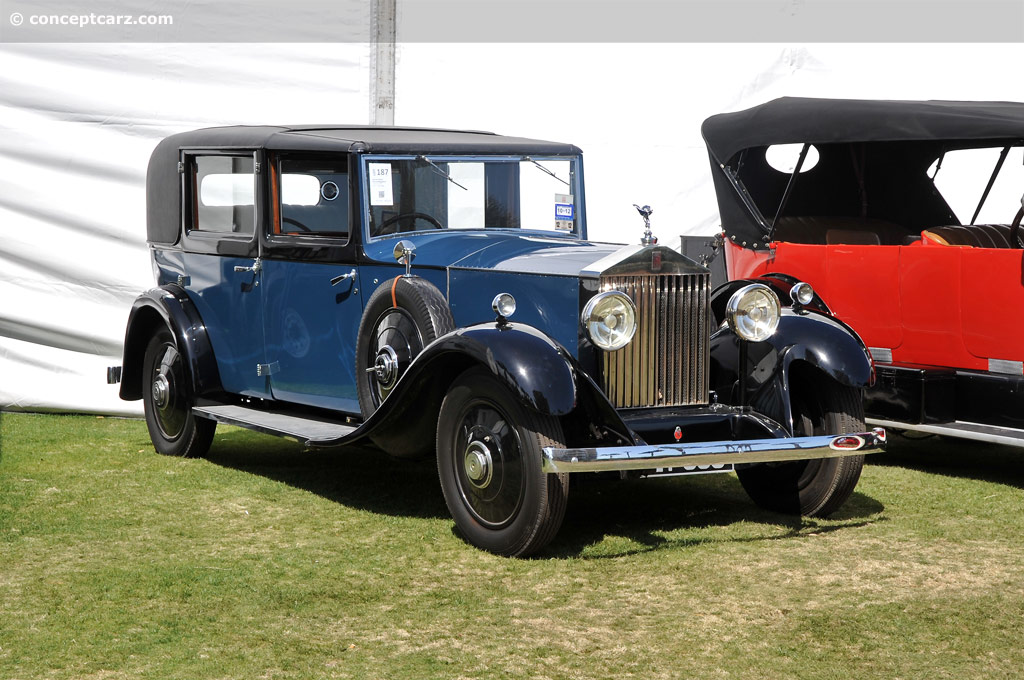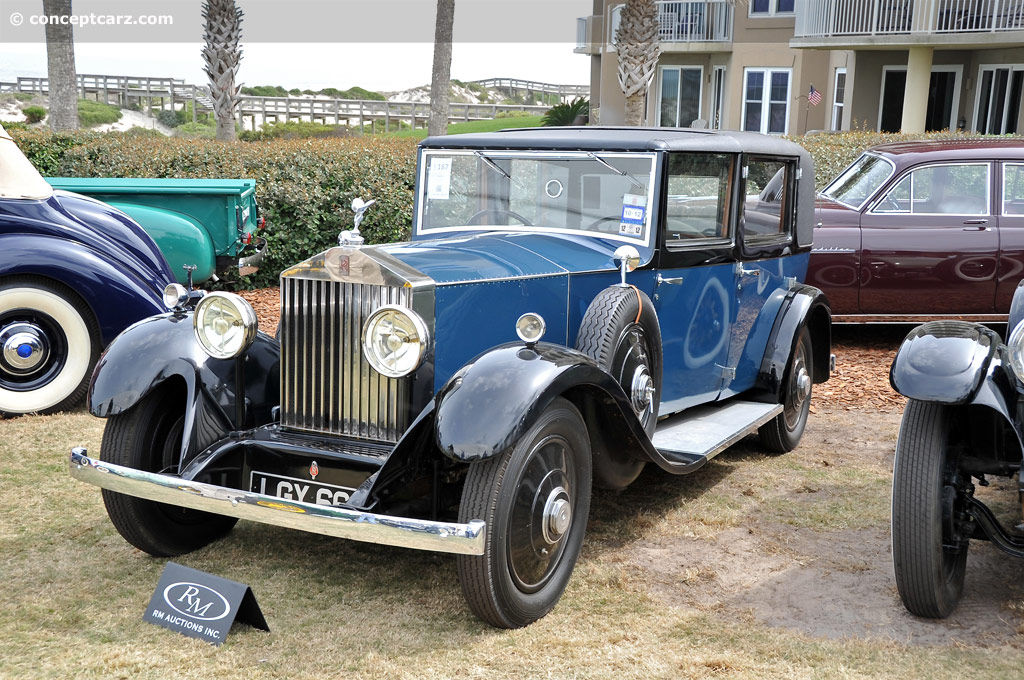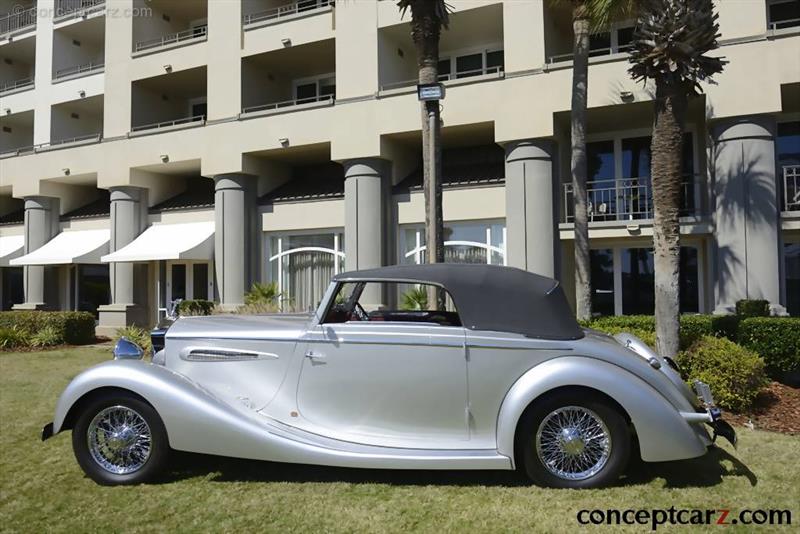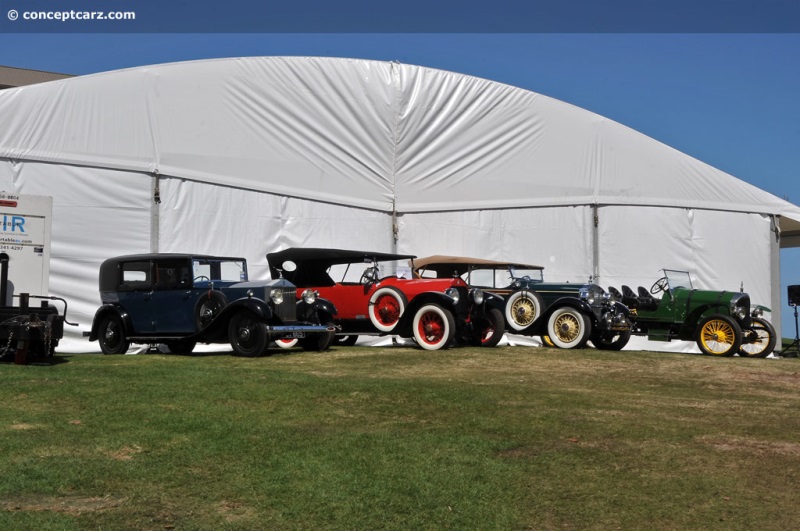Rolls-Royce Limited was formed on March 15th of 1906 by Frederick Henry Royce, an English engineer, and Charles Stewart Rolls, proprietor of an early motor car dealership. The company produced two-, three-, four-, and six-cylinder models before the introduction of an improved six-cylinder model initially designated the 40/50 hp. This naming scheme was devised by the British government representing horsepower output and a system of taxation. The tax rates were based on a formula based on the engine's number of cylinders, the bore, and other physical dimensions (but not their stroke). This formula calculated the vehicle's taxable horsepower, which then determined the annual road use tax. The tax brackets were divided by single whole horsepower increments up to and including twenty. The 40/50 was one of the largest (if not the largest). 
Sedanca deVille by Park Ward & Co.
Chassis #: GFT 72
View info and history
Auction entries : 1The Silver Ghost
The car adopted the 'Silver Ghost' name after chassis number 60551, a whisper-quiet, silver-painted, semi-Roi-des-Belges open tourer with coachwork by Barker. The 40/50 cars would use the Silver Ghost name until the introduction of the 40/50 New Phantom in 1925. 7,874 examples were made, including 1701 from the American Springfield factory. The Phantom
The New Phantom was produced from 1925 through 1931 with 3,512 examples built during that time. Rolls-Royce never used the 'Phantom I' designation, but was later applied by enthusiasts to aid in distinguishing it from other generations with the same model name. The Phantom II that followed (the third and final 40/50 hp model) was built from 1929 through 1936 with 1,680 examples built. The Phantom III of 1936 to 1939 (727 examples built) was a twelve-cylinder model and the final large pre-war model for the company.The Silver Ghost was powered by a side-valve, six-cylinder engine that initially displaced 7,036cc, growing to a displacement size of 7,428cc in 1910. The engine used a seven-bearing crankshaft, full pressure lubrication, two spark plugs per cylinder, and cylinders cast in two units of three-cylinder each. It was paired with a three-speed transmission that gave way to a four-speed unit in 1913. The New Phantom (Phantom I) had a 7,668cc straight-6 engine with new pushrod overhead valves and constructed as two groups of three cylinders with a single detachable head. The Phantom II added a new crossflow cylinder head and the engine was connected directly to the four-speed manual transmission. Similar to the Silver Ghost, the Phantom I had a separate gearbox connected through a rubberised fabric flexible coupling to the clutch and through a torque tube enclosed drive to the differential.The Twenty
The Silver Ghost and the New Phantoms were larger vehicles with many being driven by chauffeurs. In 1922, Rolls-Royce added a new model to the lineup dubbed the Twenty, as an owner-driver vehicle. The Silver Ghost rested on a 143.5-inch wheelbase platform (135.5-inches from 1906 through 1913, and 144- and 150.5-inches from 1923) while the Twenty used a smaller 128.9-inch wheelbase platform. Like the Silver Ghost, Rolls-Royce produced the chassis and mechanical components while the coachwork was outsourced to coachbuilders selected by the owner. The list of coachbuilders who created bodies for the Twenty includes Thrupp & Maberly, Hooper, Mulliner, Barker, and Park Ward.
Sedanca deVille by Park Ward & Co.
Chassis #: GFT 72
View info and history
Auction entries : 1Power was from a new inline-6 cylinder overhead valve engine with a bore of 76mm and a stroke of 114mm, resulting in a 3,127cc displacement. Used later on the New Phantom, the cylinders were cast in one block and the cylinder head was detachable. Early models received a three-speed manual gearbox with the gearshift lever in the center of the car. In 1925, a four-speed unit with a traditional right-hand configuration replaced the previous 3-speed unit. The chassis employed rigid front and rear axles suspended by half-elliptic springs. Stopping power was by rear wheel brakes but in 1925, four-wheel brakes with mechanical servo became standard. The Rolls-Royce 20/25
Introduced at the 1929 Olympia Motor Show, the Rolls-Royce 20/25 (code named 'Goshawk') replaced the position performed by its predecessor, the Twenty. It quickly became the company's most successful interwar model, with approximately 3,827 rolling chassis produced through 1936. All wore bespoke coachwork and many of the customers were nobility, 'old money', and the social elite. Engineering quality reflected Rolls-Royce's reputation for building 'The Best Car in the World' and a comprehensive dealer network serviced the marque, working closely with the factory in providing service for their clients. The chassis was very similar to the Twenty, measuring 128.7 inches before growing to 131.9-inches in 1930. Semi-elliptic leaf springs and hydraulic dampers were placed in the front and rear, and braking was by internal expanding four-wheel brakes with an independent handbrake for the rear wheels, and a mechanical servo motor driven from the gearbox. Steering was by worm and nut and the chassis lubrication system was a 'One-Shot' Bijur centralized unit. The engine's bore increased from 3 to 3.25-inches but the stroke remained unchanged at 4.5-inches. Displacement increased to 3,675cc and the (RAC) output was 25.4 horsepower. It had overhead pushrod operated valves, a separate cast-iron block, an aluminum crankcase, a detachable cast iron 6-plug head, and a 7-bearing crankshaft with a vibration damper. A four-speed manual transmission sent the power to the rear wheels.
Sedanca deVille by Park Ward & Co.
Chassis #: GFT 72
View info and history
Auction entries : 1Among the coachbuilders who bodied the 20/25 were Thrupp & Maberly, Mullin, Hooper, Carlton, and Park Ward. The 1931 Rolls-Royce 20/25
Improvements made to the 20/25 for the 1931 model year included an automatic control via a thermostat replacing the previous manually operated radiator shutters. An anti-splash radiator cap and a reserve petrol supply were also added. For 1932, thermostatically-controlled shutters were added and the previous fourteen-gallon rear trank was replaced by an eighteen-gallon unit. Additional updates included a high-lift camshaft, an increase in engine compression from 5.25:1 to 5.75:1, double-acting hydraulic shock dampers, and a completely centralized chassis lubrication system. Synchromesh was now on the third and top gears.
by Daniel Vaughan | Apr 2022

Sedanca deVille by Park Ward & Co.
Chassis #: GFT 72
View info and history
Auction entries : 1
The car adopted the 'Silver Ghost' name after chassis number 60551, a whisper-quiet, silver-painted, semi-Roi-des-Belges open tourer with coachwork by Barker. The 40/50 cars would use the Silver Ghost name until the introduction of the 40/50 New Phantom in 1925. 7,874 examples were made, including 1701 from the American Springfield factory. The Phantom
The New Phantom was produced from 1925 through 1931 with 3,512 examples built during that time. Rolls-Royce never used the 'Phantom I' designation, but was later applied by enthusiasts to aid in distinguishing it from other generations with the same model name. The Phantom II that followed (the third and final 40/50 hp model) was built from 1929 through 1936 with 1,680 examples built. The Phantom III of 1936 to 1939 (727 examples built) was a twelve-cylinder model and the final large pre-war model for the company.The Silver Ghost was powered by a side-valve, six-cylinder engine that initially displaced 7,036cc, growing to a displacement size of 7,428cc in 1910. The engine used a seven-bearing crankshaft, full pressure lubrication, two spark plugs per cylinder, and cylinders cast in two units of three-cylinder each. It was paired with a three-speed transmission that gave way to a four-speed unit in 1913. The New Phantom (Phantom I) had a 7,668cc straight-6 engine with new pushrod overhead valves and constructed as two groups of three cylinders with a single detachable head. The Phantom II added a new crossflow cylinder head and the engine was connected directly to the four-speed manual transmission. Similar to the Silver Ghost, the Phantom I had a separate gearbox connected through a rubberised fabric flexible coupling to the clutch and through a torque tube enclosed drive to the differential.The Twenty
The Silver Ghost and the New Phantoms were larger vehicles with many being driven by chauffeurs. In 1922, Rolls-Royce added a new model to the lineup dubbed the Twenty, as an owner-driver vehicle. The Silver Ghost rested on a 143.5-inch wheelbase platform (135.5-inches from 1906 through 1913, and 144- and 150.5-inches from 1923) while the Twenty used a smaller 128.9-inch wheelbase platform. Like the Silver Ghost, Rolls-Royce produced the chassis and mechanical components while the coachwork was outsourced to coachbuilders selected by the owner. The list of coachbuilders who created bodies for the Twenty includes Thrupp & Maberly, Hooper, Mulliner, Barker, and Park Ward.

Sedanca deVille by Park Ward & Co.
Chassis #: GFT 72
View info and history
Auction entries : 1
Introduced at the 1929 Olympia Motor Show, the Rolls-Royce 20/25 (code named 'Goshawk') replaced the position performed by its predecessor, the Twenty. It quickly became the company's most successful interwar model, with approximately 3,827 rolling chassis produced through 1936. All wore bespoke coachwork and many of the customers were nobility, 'old money', and the social elite. Engineering quality reflected Rolls-Royce's reputation for building 'The Best Car in the World' and a comprehensive dealer network serviced the marque, working closely with the factory in providing service for their clients. The chassis was very similar to the Twenty, measuring 128.7 inches before growing to 131.9-inches in 1930. Semi-elliptic leaf springs and hydraulic dampers were placed in the front and rear, and braking was by internal expanding four-wheel brakes with an independent handbrake for the rear wheels, and a mechanical servo motor driven from the gearbox. Steering was by worm and nut and the chassis lubrication system was a 'One-Shot' Bijur centralized unit. The engine's bore increased from 3 to 3.25-inches but the stroke remained unchanged at 4.5-inches. Displacement increased to 3,675cc and the (RAC) output was 25.4 horsepower. It had overhead pushrod operated valves, a separate cast-iron block, an aluminum crankcase, a detachable cast iron 6-plug head, and a 7-bearing crankshaft with a vibration damper. A four-speed manual transmission sent the power to the rear wheels.

Sedanca deVille by Park Ward & Co.
Chassis #: GFT 72
View info and history
Auction entries : 1
Improvements made to the 20/25 for the 1931 model year included an automatic control via a thermostat replacing the previous manually operated radiator shutters. An anti-splash radiator cap and a reserve petrol supply were also added. For 1932, thermostatically-controlled shutters were added and the previous fourteen-gallon rear trank was replaced by an eighteen-gallon unit. Additional updates included a high-lift camshaft, an increase in engine compression from 5.25:1 to 5.75:1, double-acting hydraulic shock dampers, and a completely centralized chassis lubrication system. Synchromesh was now on the third and top gears.
by Daniel Vaughan | Apr 2022
Related Reading : Rolls-Royce 20/25HP History
Rolls-Royce introduced the replacement for the Twenty in 1929, dubbed the 2025 HP, and utilized the chassis of its predecessor. The engine was enlarged from 3.1 liters to 3.7 liters, giving a significant increase in performance. Improved power had become a necessity because owners often insisted on fitting elaborate and heavy coachwork, which severely affected the performance. This was an important....
Continue Reading >>
Continue Reading >>
1931 Rolls-Royce 20/25 Vehicle Profiles
Recent Vehicle Additions
Performance and Specification Comparison
20/25HP Specification Comparison by Year
Year
Production
Wheelbase
Engine
Prices
Related Automotive News

AUCTIONS AMERICA KICKS OFF ITS 2016 SEASON WITH $20 MILLION IN SALES AND 40 PERCENT NEW BIDDERS AT FORT LAUDERDALE
Auctions Americas 14th annual Fort Lauderdale collector car auction generates %2420 million in sales
Diverse top-sellers list led by 1971 Ferrari 365 GTB4 Daytona at %24649,000
Rare American muscle and desirable Mercedes-Benzes attract significan...

63rd Pebble Beach Concours d'Elegance Names 1934 Packard 'Best of Show'
The competition showcased 248 cars, including 48 from abroad
PEBBLE BEACH, Calif. (August 18, 2013) -- A 1934 Packard 1108 Twelve Dietrich Convertible Victoria owned by Joseph and Margie Cassini III of West Orange, New Jersey, was named Best...

RM Auctions' Don Davis Collection Attracts Texas-Size Bids
RM Auctions posts over %2421.2 million at the record-breaking sale of the distinguished Don Davis Collection, April 27 in Fort Worth, Texas
Top seller a rare 1967 Ferrari 330 GTS sold for %241,936,000, to establish a new auction record
Five lots a...

TOPLINE COLLECTORS PLACE SPOTLIGHT on SPEED'S BARRETT-JACKSON BROADCAST FROM SCOTTSDALE
TOPLINE COLLECTORS PLACE SPOTLIGHT on SPEEDS BARRETT-JACKSON BROADCAST FROM SCOTTSDALE
LOST SHELBY DUAL PROTOTYPE, HAGERTY GIVEAWAY %26 SALON COLLECTION HIGHLIGHT 39 HOURS OF LIVE COVERAGE
The 42nd annual Barrett-Jackson Scottsdale (Ar...

Famous Bentley 4¼-Litre 'Embiricos' Special Makes Star Appearance At Crewe Factory
One of the rarest and most valuable Bentleys in the world, the 4¼-Litre Embiricos special, is making an historic appearance at the marques home in Crewe. Fresh from taking part in the Louis Vuitton Serenissima Run in Venice and featuring at the...

























